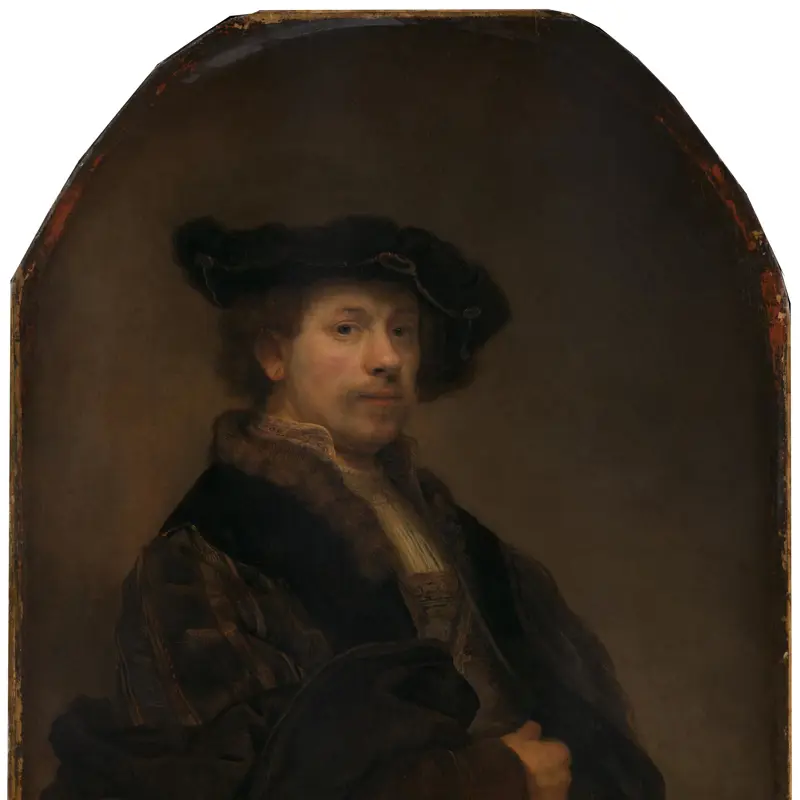Rembrandt, 'Ecce Homo', 1634
About the work
Overview
‘Ecce Homo’, the Latin title of this painting, is taken from the Bible, and means ‘Behold the man!’ These were the words of Pontius Pilate, the Roman governor of Judea, when he was sitting as the judge during the trial of Christ. Pilate, here shown wearing a turban and rising to his feet, is presenting Christ to the crowd. The picture evokes the fevered atmosphere of this show trial and is dominated by images of earthly power and authority. Christ stands slightly higher than his captors – he’s the only figure looking upwards towards the ’true' judge, God.
This small black and white painting (known as a grisaille) was not made for sale. It is a full-scale preparatory study for one of Rembrandt’s etchings – the only known example of such a work. Rembrandt was a prolific print maker and his studio produced hundreds of images for sale. This was one of his most popular.
Key facts
Details
- Full title
- Ecce Homo
- Artist
- Rembrandt
- Artist dates
- 1606 - 1669
- Date made
- 1634
- Medium and support
- oil on paper, mounted on canvas
- Dimensions
- 54.5 × 44.5 cm
- Inscription summary
- Signed; Dated
- Acquisition credit
- Bought, 1894
- Inventory number
- NG1400
- Location
- Room 22
- Collection
- Main Collection
- Previous owners
Provenance
Additional information
Text extracted from the ‘Provenance’ section of the catalogue entry in Neil MacLaren, revised and expanded by Christopher Brown, ‘National Gallery Catalogues: The Dutch School: 1600–1900’, London 1991; for further information, see the full catalogue entry.
Exhibition history
-
2008Rembrandt. History PainterMuseo Nacional del Prado15 October 2008 - 6 January 2009
-
2012Rembrandt and the Passion (Hunterian)Hunterian Museum15 September 2012 - 2 December 2012
-
2016Rembrandt intimeMusée Jacquemart-André16 September 2016 - 23 January 2017
-
2017Rubens and RembrandtThe National Gallery (London)22 March 2017 - 6 August 2017
-
2017Monochrome: Painting in Black and WhiteThe National Gallery (London)30 October 2017 - 18 February 2018
-
2017Monochrome: Painting in Black and White.Museum Kunstpalast22 March 2018 - 15 July 2018
-
2018Rembrandt: Painter as PrintmakerDenver Art Museum16 September 2018 - 6 January 2019
-
2019Young RembrandtStedelijk Museum De Lakenhal1 November 2019 - 9 February 2020The Ashmolean Museum of Art and Archaeology27 February 2020 - 1 November 2020
Bibliography
-
1753Z.C. von Uffenbach, Merkwürdige Reisen durch Niedersachsen, Holland und England, Frankfurt am Main 1753
-
1829
J. Smith, A Catalogue Raisonné of the Works of the Most Eminent Dutch, Flemish, and French Painters: In Which is Included a Short Biographical Notice of the Artists, with a Copious Description of Their Principal Pictures […], 9 vols, London 1829-1842
-
1844Christie, Manson & Woods, A Catalogue of the Very Celebrated Collection of Pictures, of Jeremiah Harman, Esq., Deceased, and Removed from Higham House, Woodford, London, 17 May 1844 - 18 May 1844
-
1883E. Dutuit, L'œuvre complet de Rembrandt, Paris 1883
-
1897W. von Bode and C. Hofstede de Groot, The Complete Work of Rembrandt, 8 vols, Paris 1897
-
1907C. Hofstede de Groot, Catalogue Raisonné of the Works of the Most Eminent Dutch Painters of the Seventeenth Century, 10 vols, London 1907
-
1907C. Hofstede de Groot, Catalogue Raisonné of the Works of the Most Eminent Dutch Painters of the Seventeenth Century, 10 vols, London 1907
-
1909A. Rosenberg and W.R. Valentiner, Rembrandt: Des Meisters Gemalde mit einer biographischen Einleitung, Stuttgart 1909
-
1922A.P. Laurie, 'The Authenticity of Rembrandts', The Connoisseur, LXII, 1922, pp. 191-6
-
1948Whitechapel Art Gallery, 5 Centuries of European Painting: Pictures lent from the National Gallery, the Cook Collection, and the Collection of Viscount Bearsted (exh. cat., Whitechapel Art Gallery, 3 February 1948 - 14 March 1948), London 1948
-
1960Maclaren, Neil, National Gallery Catalogues: The Dutch School, 2 vols, London 1960
-
1967E. Haverkamp-Begemann, 'Purpose and Style in Oil Sketches of Rubens, Jan Breughel, Rembrandt', in Stil und Überlieferung in der Kunst des Abendlandes, Berlin 1967, vol. 3, pp. 104-13
-
1973J.G. van Gelder, 'Frühe Rembrandt-Sammlungen', in O. von Simson and J. Kelch (eds), Neue Beiträge zur Rembrandt-Forschung, Berlin 1973, pp. 189-206
-
1984M. Royalton-Kisch, 'Over Rembrandt en Van Vliet', Kroniek van het Rembrandthuis, 1-2, 1984, pp. 3-23
-
1984M. Royalton-Kisch, 'Rembrandt: Two Passion Prints Reconsidered', Apollo, CXIX/264, 1984, pp. 130-2
-
1985G. Schwartz, Rembrandt: His Life, His Paintings, Harmondsworth 1985
-
1985National Gallery, 'Pictures Cleaned and Restored in the Conservation Department of the National Gallery, January 1984 - December 1984', National Gallery Technical Bulletin, IX, 1985
-
1988D. Bomford et al., Rembrandt (exh. cat. The National Gallery, 12 October 1988 - 17 January 1989), London 1988
-
1989M. Royalton-Kisch, 'Rembrandt's Sketches for His Paintings', Master Drawings, XXVII/2, 1989, pp. 128-45
-
1991Maclaren, Neil, revised by Christopher Brown, National Gallery Catalogues: The Dutch School, 1600-1900, 2nd edn (revised and expanded), 2 vols, London 1991
-
1991C. Brown, J. Kelch and P.J.J. van Thiel, Rembrandt: The Master and his Workshop (exh. cat. Gemäldegalerie SMPK at the Altes Museum, 12 September - 10 November 1991; Rijksmuseum, 4 December - 1 March 1992; The National Gallery, London, 25 March - 24 May 1992), New Haven 1991
-
1993C. Tümpel, Rembrandt: All Paintings in Colour, Antwerp 1993
-
1995P. Kaenel, 'L'énigme du "Christ présenté au Peuple" (1655) de Rembrandt ou les limites de la vraisemblance iconologique', in L. Golay et al., Florilegium. Scritti di storia dell'arte in onore di Carlo Bertelli, Milan 1995, pp. 177-83
-
1995M. Royalton-Kisch, 'Rembrandt's Clock', in C.P. Schneider, W.W. Robinson and A.I. Davies (eds), Shop Talk. Studies in Honour of Seymour Slive, Cambridge MA 1995, pp. 216-8
-
2000S.D. Squarzina, 'Rembrandt mennonita', Arts, IV/1, 2000, pp. 78-86
-
2000E. Hinterding, G. Luijten and M. Royalton-Kisch, Rembrandt the Printmaker (exh. cat. Rijksmuseum, 22 July - 8 October 2000 and 14 October 2000 - 7 January 2001; British Museum, 26 January - 8 April 2001), Amsterdam 2000
-
2001
C. Baker and T. Henry, The National Gallery: Complete Illustrated Catalogue, London 2001
-
2003C.S. Ackley et al., Rembrandt's Journey: Painter, Draftsman, Etcher (exh. cat. Museum of Fine Arts, 26 October 2003 - 18 January 2004; Art Institute of Chicago, 14 February - 9 May 2004), Boston 2003
-
2005J. Bruyn et al., A Corpus of Rembrandt Paintings, Dordrecht 2005
-
2006D. Bomford et al., Rembrandt, London 2006
-
2009M. Alexander-Knotter, 'Rembrandt's Hebrew', in H. Bevers and J. Kelch (eds), Rembrandt: Wissenschaft auf der Suche, Berlin 2009, pp. 25-38
About this record
If you know more about this work or have spotted an error, please contact us. Please note that exhibition histories are listed from 2009 onwards. Bibliographies may not be complete; more comprehensive information is available in the National Gallery Library.


























